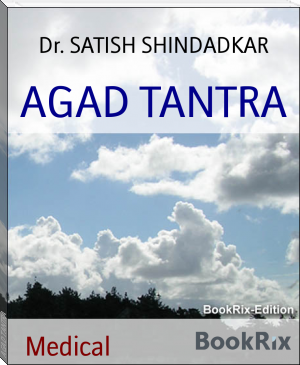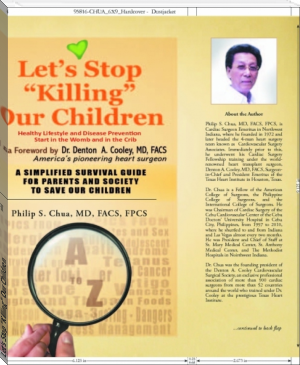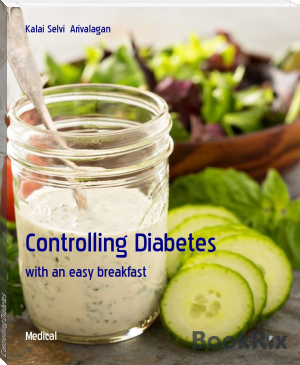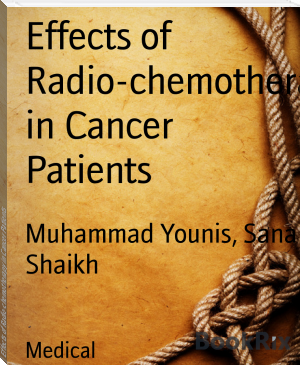AGAD TANTRA, Dr. SATISH SHINDADKAR [web based ebook reader .txt] 📗

- Author: Dr. SATISH SHINDADKAR
Book online «AGAD TANTRA, Dr. SATISH SHINDADKAR [web based ebook reader .txt] 📗». Author Dr. SATISH SHINDADKAR
Lathyrus sativa : (लाखी दाल/केशरी दाल)
Consumption of Kesaridal for more than 6 months with 30 % or more part of diet causes lathyrism (a neurotoxin disease – characterized by paralysis of lower limbs).
The neurotoxin principle is free amino acid. If it is boiled for 2 hrs & the water is then decanted, almost 85 % of toxic amino acid is eliminated.
Bhavaprakash specially mention the disease paralysis of legs due to kesari dal.
Mashrooms :
There are varieties of mashroom – Poisonous & non poisonous.
The poisoning is usually accidental & rarely homicidal.
Symptoms :
Symptoms of toxicity appear after 6-12 hrs. They are of GIT irritation followed by cyanosis, slow pulse and difficulty in breathing, convulsions, sweating, collapse & death.
The neurotic symptoms are giddiness, delirium, headache, diplopia, constriction of pupils, cramps, twitching of muscles of limbs, salivation, bradycardia and coma. Hepatic & renal toxicity may be seen after 3-6 days.
Fatal dose : 2-3 mushrooms
Fatal period - usually 24 hrs.
Treatment - Gastric lavage
Forced diuresis
Haemodialysis
Symptomatic treatment.
Benzyl penicilline 3 lakhs – 1 million units per day.
Post mortem appearances :
Signs of GIT irritation, Fatty degeneration of liver, heart & kidney. In case of neurotic symptoms – congestion of the brain & petechial heamorrhage in serous membrances.
Rye (Secale cereale)
Rye grain is used for flour, bread, beer, whiskeys, vodkas & animal food.
Rye is highly susceptible to the ergot fungus : Consumption of ergot infected rye by humans & animals results in a serious condition called ergotism.
Ergotism can cause both physical & mental harm, including, convulsions, miscarriage, necrosis of digits, hallucinations & death.
Symptomatic treatment should be given.
Oats :
Oats have no toxic effects when consumed in suitable dose. The plant may cause dermal reaction [ to the person allergic to proteins in oats.]
Oats can be used for gallstone disease, liver disease, itching, etc.
Oats have toxic effect on those people suffering from celiac disease.
Celiac disease – a chronic nutritional disturbance, usually of young children, caused by the inability to metabolise gluten, which results in malnutrition, a distended abdomen, muscle wasting & the passage of stool having high fat content.
Composition of oat protein is similar to wheat gulten.
Excess consumption of oat may cause headache, stomach upset, cancer etc.
Treatment – Symptomatic treatment should be given.
Exclusion of grains containing gluten. e.g. wheat, rye, barley, oats etc.
Green barley grass :
Juice of green barley grass is a very concentrated source of nutrients & used for weight control, detoxification, blood sugar control, anti oxidant, diagestive aid, anti inflammatory, blood tonic etc.
Due to detoxifying nature mild headache, diarrhoea & other miscellaneous symptoms can occur.
Juice of green barley grass is very similar to green wheat grass juice.
Onion :
There is no toxic effect of onion when consumed in suitable dose.
If whole onion plant is consumed, heart burn or ulcers can be caused.
The Skin of onion bulb contact could cause allergic reactions in people who are hyper sensitive to the plant.
Onion bulb consumption in higher dose can cause vomiting & stomach pains.
Cotton Seeds :
Cotton seed oil contains a toxic pigment C30H30O8 called gossypol.
Gossypol poisoning, which is usually sub acute – to chronic, cumulative & sometimes insidious, follows consumption of cotton seed or cotton seed products that contain excess free gossypol.
Gossypol is present in whole cotton plant. Cotton seed contains both protein bound & free form of gossypols only the free form is toxic.
Its main toxic effect is inhibition of sperm production which occurs after long term consumption. ( from weeks to months).
Atropa belladonna :
Family – Solanaceae.
It is perennial herb. Leaves are alternate & simple. Flowers are same as dhatura flowers, fruit is glossy. Berries are purple black.
Poisonous part - All parts mainly berries.
Toxic principle - Tropane alkaloids atropine.
Hyoscine (scopolamine)
Hyoscyamine etc.
Symptoms of poisoning and treatment is similar as in datura poisoning.
All parts of belladonna plant are toxic Even handling the plant can cause irritation. Belladonna berries are dangerous to children as it looks very attractive and taste is sweet.
In children - 2-5 berries.
In adult - 10-20 berries.
1 leaf.
Argemone Mexicana :
Mexicana seeds contains 22-36 % pale yellow, non edible oil, called argemone oil or katkar oil.
The seeds resemble mustard seeds. Hence, argemone seeds are used to adulterate mustard seeds.
Poisonous part – All parts, mainly seeds.
Toxic principle – Isoquinoline alkaloids.
Toxic Symptoms –
Vomitting, diarrhea, visual disturbances, fainting and coma.
These toxic symptoms appear only if large quantity is eaten.
Argemone oil poisoning causes epidemic dropsy (edema of extremities) particularly extreme swelling of the legs.
Treatment –
Withdrawal of seeds or oil from cooking.
Bed rest with leg elevation and protein rich diet.
Supplements of calcium, antioxidants and vit-B are commonly used.
Rest symptomatic treatment should be given.
***
Food poisoning
The term food poisoning in its wider sense includes all illnesses which results from ingestion of food containing non bacterial or bacterial products.
When the term is used in its special or restricted sense it means that, the poisoning is due to bacterial products only.
The bacterial products include bacteria and their toxins.
The non bacterial products include poisons derived from plants, animals and inorganic chemicals.
The illness is characterised by
Simulteneous attack of many persons at the same time.
H/o ingestion of common food by all suffers.
Similarity of signs and symptoms in a mejority of cases.
A medical practioner coming across a case of food poisoning from a public eating house must report it to public health authority.
Causes :
Bacterial :- Infection type, toxin type, Botulism.
Non bacterial type – i.e. poisonous food.
Poisons of vegetable origin
Poisons of animal origin – Poisonous fish mussel.
Chemicals – Intentionally added
Accidentally added.
Bacterial food poisoning :
Infection type :
This results from ingestion of liable micro organism that multiplies in the GIT and produce a true infection.
e.g. Salmonella group of organisms.
- S. enteridis
- S. typhinurium
- Protens
- Coligroup
- Streptococci
The salmonella invade and destroy the mucosa of small intenstine.
The natural reservoir of salmohelk organism is in certain birds, mammals and reptiles.
Food may be contaminated with infected excreta of mice or rats or infection may be transferred by flies or by human carriers employed in the handling of food.
The outbreak of salmonella food poisoning is likely to occur whenever large amount of food prepared and the unconsumed food kept for future meal or uncooked food or imperfectly cooked food.
Accordingly, such food poisoning is reported far more frequently from canteens, restaurants, hospitals and other institutions than from private houses.
Signs and symptoms :
Depending upon the susceptibility of individuals to salmonella food poisoning some may be severely affected.
Incubation period is longer than staphylococcal food poisoning delay of 12 hrs or more is usual.
The onset is sudden-The chill may be the initial symptom, followed by severe abdominal cramps, headache, nausea, weakness, vomiting etc.
The diagnosis rest on the isolation of the causative organism from the patient and suspected articles of food.
Diagnosis – made from :
i) History
ii) Clinical feature.
[Three characteristics that differentiate it from staphyloccal food poisoning- Muscular weakness, Fever, Persistent, very foul smelling diarrhea]
Treatment :
Gastric Lavage.
Bowel is emptied by purgatives if diarrhea is not present.
Antiboitics – for salmonella – choice chloramphericol Ampicillin, septran. Shigella – ampicillin, tetracyclines etc.
Symptomatic treatment should be given.
PM appearances :
One of gastroenteritis and general toxaemia. Mucosa of stomach and intestine is swollen and often intensely congested and there may be ulceration. Microscopic examination shows fatty degeneration of liver.
Toxin type :
This type of food poisoning results due to toxins produced by multiplying organisms that have gained access to prepared food. e.g. enterotoxin produced by staphylococci.
For this type of poisoning to occur.
The food must be contaminated by a strain of organism that produce enterotoxins.
It must be suitable for growth of organism.
The infected food must be kept at a temp. Suitable for bacterial growth and for sufficiently long time so that appreciable quantity of enterotoxin is formed.
Food such as milk, custard, previously prepared meat dishes are the chief sources
Most cases are due to some strains of staphylococci which produce a heat stable enterotoxin.
Other toxin producing organisms – proteus vulgaris, streptococci, B.coli, Clostridium welchii.
Signs and symptoms :
Toxin being present in food, the symptoms develop rapidly within 1 to 4 hrs.
The first symptom is salivation, followed by acute gastroenteritis and recovery within 24 hrs.
Treatment :
Same as infective type.
Prophylaxis :
Meat inspection at the slaughter house.
The rodents should be driven out from food industry is carried on.
Carriers should not be employed in dairies and in food industry.
Preserved foods should be properly checked.
C] Botulism : Botulism is an intoxication, not an infection
This form of food poisoning differs from the other two types, in that there are no symptoms of gastroenteritis, although poisoning results from absorption of a specific toxin from the alimentary canal.
It does not grow in body but produces a potent neurotoxin.
It is normally present in soil and contamination occurs by contact soil generally in food and vegetables.
The toxin inhibits acetylcholine.
The toxin is destroyed by heat at 80OC for 30 min or 1000 c for 10 min.
The causative organism Cl. botalinum multiplies in the food. e.g. sausages, tinned meat, fish, fruits etc. before it is consumed and produces a powerful exotoxin.
The fatal dose in adults is 0.01 mg or even less.
The toxin paralyses the nerve endings, by blocking the nerve impulses at myoneural junctions.
It blocks the action of acetylcholine.
It's action is selective being confined to the cholinergic fibers of the autonomic nervous system.
Signs and symptoms :
The incubation period varies from 12-30 hrs. but may be prolonged to 72 hr.
Symptoms are due to action of toxin on CNS
The initial GI symptoms include
Nausea, Vomiting, Abdomimal Distention, Pain
Later symptoms are
Dry or sore throat and mouth, Difficulty in visual accommodation , Dysphonia, Diplopia, Discending motor paralysis [Initiated from abducent or occulomotor nerve] Dysphagia , Constipation, Respiration insufficiency, Urinary retention etc.
The patient is conscious unitll death. Coma and delirium may precede death.
Death may occur in 24 hr.
In those who servive, complete recovery of ocular movements may not take place for 6-8 months.
D.D : Encephalitis, Multiple sclerosis, GB syndrome, Diphtheria, Tetanus, CO poisoning, OPC poisoning, Elapid snake bites etc.
PM : Kidney, liver and meninges are congested.
Histological examination of organs may show thrombosis.
Diagnosic : is made from
History, Clinical features, Demonstration of toxin in suspected food, isolation of basillus from the food, isolation of the toxin in the blood and tissue, isolation of the basillus from the patient's, feaces or vomit, intestinal contents and viscera.
Treatment :
i. Gastric lavage or emesis
ii. Activated charcoal
iii. Purgative
iv Whole bowel irrigation.
v Botalinum antitoxin (type A, B and E)
One vial by slow i.v. in NS and one vial i.m. and repeated 2-4 hrs intervals i.v.
vi Botulism immune globulin
Is pentavalent for types A,B,C, D and E, 50 ml is given i.v. daily till the patient is recovered.
vii Adezuate respiration
viii Alcohol precipitates toxin – frequent small doses of brandy are beneficial.
12) जंगम विष : सर्प SNAKE VENOM
आयुर्वेदानुसार सर्प वर्गीकरण - सर्प – मुख्य 2 प्रकार
भौम 2. दिव्य (देव स्वरूप असल्याने सात्वीक-पूजनीय)
भौम चे ३ प्रकार – १.पुरूष 2. स्त्री ३. नपुंसक
पुन्हा भौम चे प्रमुख 4 प्रकार -
दर्वीकर (26) मंडली (22) राजिमान (10) वैकरंज (10)
भौम - वर्णानुसार पुन्हा 4 प्रकार - ब्राह्मण क्षत्रिय वैश्य शूद्र
सर्पदंश प्रकार (सुश्रुत)
अ.क्र.
प्रकार
लक्षण
1
सर्पित
दंशस्थळी एक-दोन अथवा अनेक खुणा दिसतात. मात्र रक्तस्त्राव अत्यल्प व अल्पशोथ असतो.
2
रदित
दंशस्थळी रक्त-निल-पित्त-श्वेत वर्ण असतो. अल्प विषकर दंश असतो.
3
निर्विष
दंशस्थळी एक अथवा अनेक खुणा असतात. अल्पशोथ, अल्प रक्त व अस्वस्थता वाटते.
4
सर्पांगाभिहत
अंधारात काटा वा तत्सम अणकुचिदार वस्तु टोचल्याने मनुष्यास सर्पदंशाची शंका उत्पन्न होऊन त्या भितीने संज्ञानाश होऊन सर्पदंशाची इतर लक्षणे उत्पन्न होतात.
सर्पदंश - वेगानुसार लक्षणे :
अ.क्र.
प्रकार
दर्वीकर
मंडली
राजिमान
1
रक्तदुष्टीमुळे
रक्त कृष्णवर्णी होऊन सर्वांग कृष्णवर्णी, पिप्पिलीगत संवेदना इ.
रक्त पिताभ होऊन सर्वांगदाह,
पीतावभासता.
रक्त श्वेताभ होऊन सर्वांग पाण्डुता
2
मांसदुष्टीमुळे
कृष्णाभ शोथ व ग्रंथी
पिताभ शोथ, दंशस्थानी दाह व शोथ
पांडुता, गौरव, शिर:शोथ
3
मेद दुष्टीमुळे
दंशस्थानातून स्त्राव, शिरोगौरव, स्वेदागम, दृष्टीविकृती
दंशस्थानी कोथ, अंधत्व, तृष्णा
दंशस्थानी कोथ, स्वेदाधिक्य, नासा-नेत्र यातून स्त्राव
4
कोष्ठ प्रवेश
कफप्रकोप-तंद्रा-प्रसेक-संधि विश्लेष
ज्वर
मन्यास्तंभ, शिरोगौरव
5
अस्थिदुष्टी मुळे
प्राण व अग्निदुष्टी, पर्वभेद, हिक्क, दाह
सर्वांगदाह
शीतपूर्वक ज्वर, सकष्ट शब्द
6
मज्जादुष्टीमुळे
गात्र गौरव, हृदयपीडा, मूर्च्छा
दर्वीकर प्रमाणे
दर्वीकर प्रमाणे
7
शुक्रदुष्टीमुळे
कटिपृष्ठभंग, श्वासावरोध, लालास्त्राव
दर्वीकर प्रमाणे
दर्वीकर प्रमाणे
वैकरंज सर्प दंशाने द्विदोषज व्याधी उत्पन्न होतात.
सर्पदंश - वेगानुसार विशेष आयुर्वेदिक चिकित्सा :
प्रकार
दर्वीकर
मंडली
राजिमान
प्रथम
रक्तमोक्षण
रक्तमोक्षण
रक्तमोक्षण(अलाबु) घृत+मधु अनुपाने अगद
द्वितीय
मधु+घृतानुपाने अगद
मधु+घृतानुपाने अगद, वमन-यवागू
प्रथम वमन नंतर अगद सेवन मधु+घृतानुपाने
तृतीय
विषघ्न नस्य, अंजन
तीक्ष्ण विरेचन पश्चात यवागु
विषघ्ननस्य, अंजन
चतुर्थ
वमन पश्चात स्थावर अगद यवागुपान
दर्वीकर प्रमाणे
दर्वीकर प्रमाणे
पंचम
तीक्ष्ण संशोधन -शीतोपचार
काकोल्यादिगण+अगद
तीक्ष्ण अंजन
षष्ठ
पंचम वेगा प्रमाणेच
अवपीडन नस्य-अगदाद्वारे
नस्य
सप्तम
तीक्ष्णनस्य,





Comments (0)